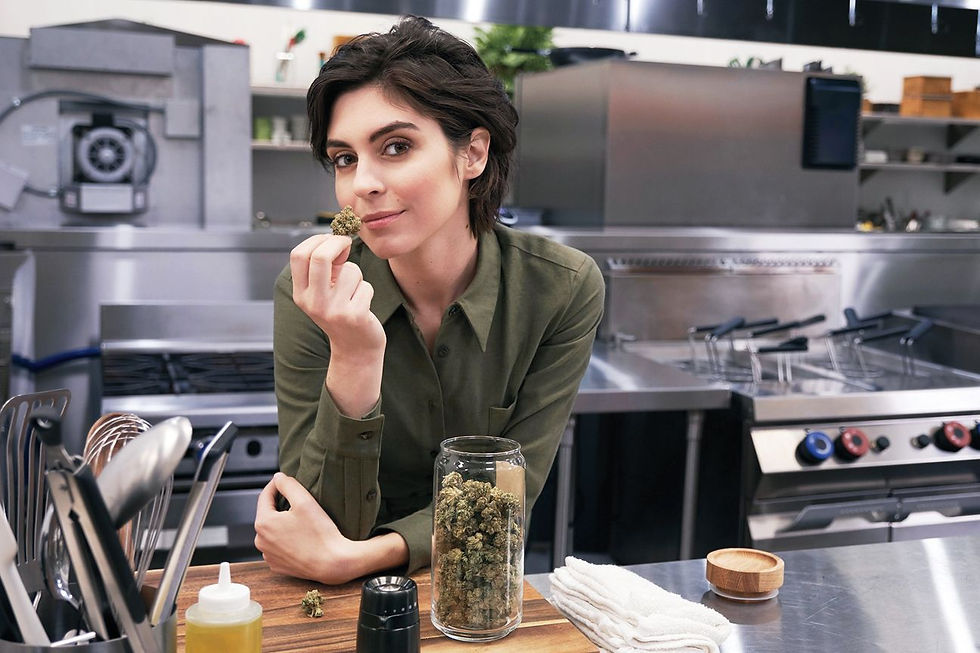Weed Chefs: The Next Big Thing
- CannaNews.Buzz
- Nov 14, 2018
- 3 min read
There’s something deeply satisfying about getting high and drooling over images of a gorgeous, marijuana-infused dinner — and a new crop of shows offer a look into how these intoxicating feasts are made.
Take Viceland’s Bong Appétit, by far the biggest hit of the genre. Last year, it was nominated for a James Beard award, a top honor in the cooking world.
The first two seasons featured dreamy sequences about sourcing local ingredients, bite-sized lessons in how to infuse various fats and oils with marijuana and, at the end of each episode, a giggle-ridden dinner party populated by the kind of chill stoners who would never judge you for being too high.

“If you’re stoned, it’s highly entertaining,” says cannabis chocolatier and co-host Vanessa Lavorato. The summer before Bong Appétit started filming, Lavorato says she slowly built up her tolerance to edibles, so she could better handle herself while stoned on air. In the end, all her hard work didn’t matter much. “You can’t hide it. You’re just really high on camera, which hopefully is funny for people.”
The show returns for a third season early next year with a new competitive format and several additions to the on-screen cast, including Cypress Hill frontman B. Real and marijuana chef Miguel Trinidad, whose underground, Filipino-inspired weed dinners have been covered by the New Yorker.
Not to be outdone, Netflix pushed out its own marijuana cooking show this summer: Cooking on High, which pits two chefs against each other to create THC-enhanced dishes for a panel of judges, punctuated by cannabis education from loveable pothead comedian Ngaio Bealum.
Though critical reception of the fell flat, some of the chefs and personalities featured within seem destined for another, better executed vehicle for stardom.
One standout was Andrea Drummer, whose delectable cod cake sandwich made her the winner of the show’s first episode. Drummer trained at Le Cordon Bleu, and oddly enough used to work as a drug prevention counselor before getting into weed cooking about five years ago.
Still, the public’s appetite for shows about weed chefs — just like the public’s appetite for weed — may be outpacing the conservative sensibilities of the people making decisions.
Food Network, among other major players, has yet to touch the subject of cooking with the federally illegal drug, so the Rachael Ray of pot cuisine is more likely to come out of an unconventional platform like California startup Prohbtd Media, which currently produces a cannabis-infused cooking web series called Pot Pie, hosted by the charming Brandin LaShea.
“Having a digital platform is the new wave,” says LaShea, who will feature infused dishes on her next season. “I have freedom that I don’t think I’d have at a large network.”
For cannabis chefs on the verge, the closed doors at most cable networks can be frustrating.
“Most of the TV people come back and say, ‘We love you, we love the concept, we’re not ready,’” says Leather Storrs, owner of the Portland, Oregon restaurant Noble Rot, who wants to host a travel-oriented cannabis food show, akin to Anthony Bourdain’s No Reservations — but with pot. “I feel like they’re looking at the middle of the country, and when you live on the coasts, it’s different.”
Storrs appeared on an early episode of Bong Appétit and is slated to return for the third season, but he’s also starred in several web series and pilots that have gone nowhere. His playful, vegetable-driven marijuana meals often start out with a Thai tom kha gai soup meant to look like Lucky Charms, with heart-shaped radishes and blue diamonds made of cabbage floating in a coconut milk broth.
And if President Trump has taught us anything, it’s that not everything that looks appealing on reality TV works well in real life. Full-scale cannabis restaurants do not yet exist, even in states that have legalized. The techniques involved in making pot-infused crème fraîche are rather complicated for a home chef, especially one who likes to get baked before baking.
And of course, achieving the correct dosage for each person at a marijuana dinner party is nearly impossible — one diner might literally require ten to twenty times as much THC as another. Perhaps that’s why it’s more entertaining to watch the making of a full weed meal than to consume one. “If I wasn’t on the show, it’s not how I would choose to be high,” says Lavorato. “I would just smoke.”

Comments